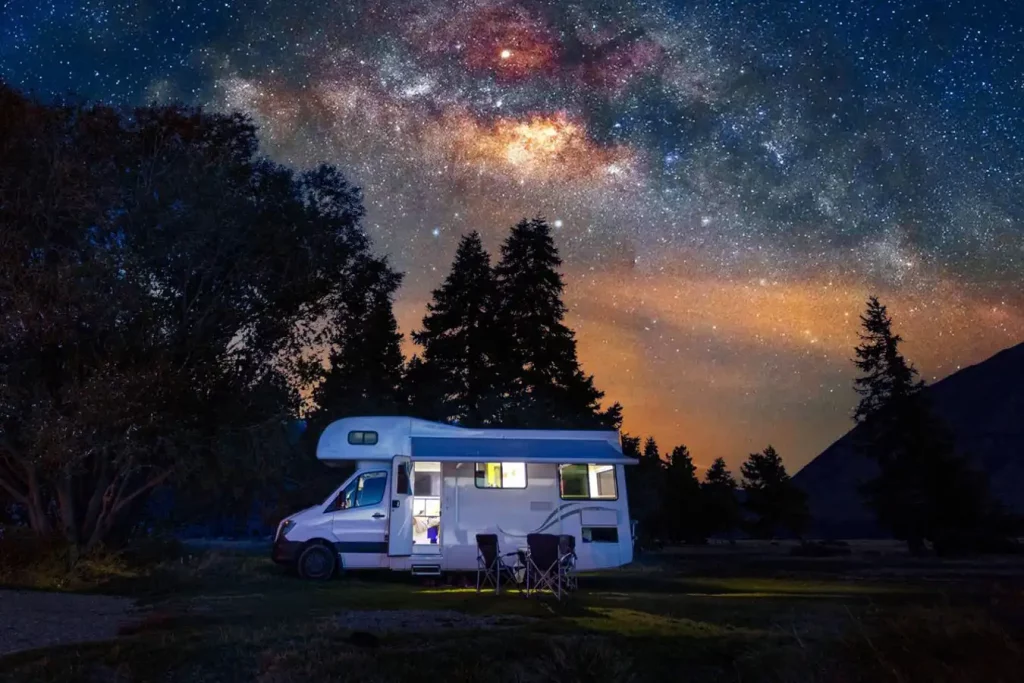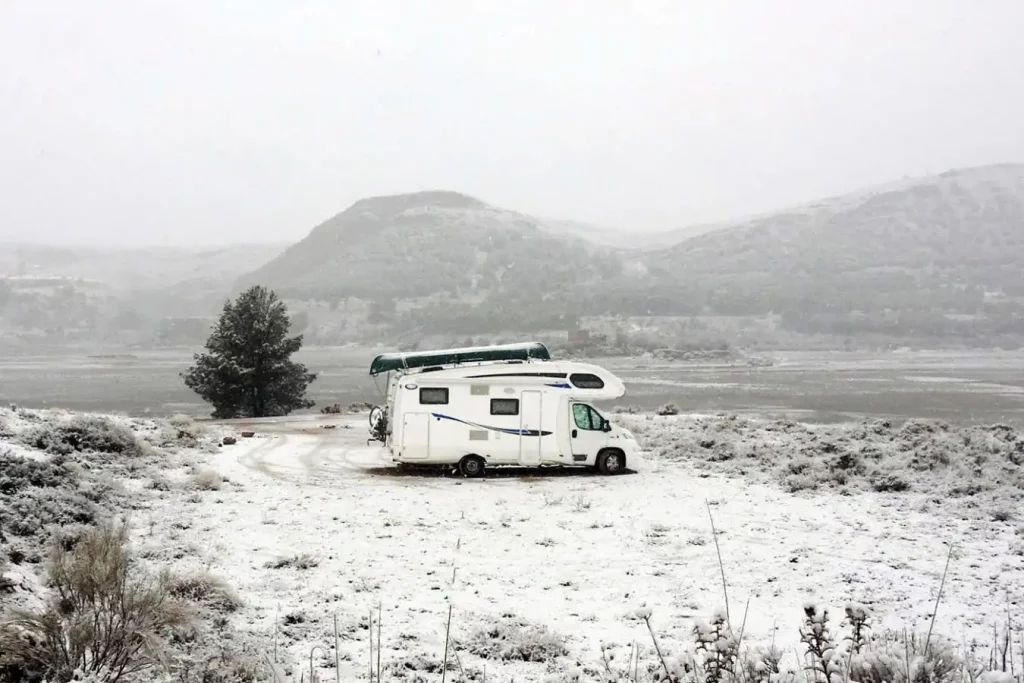“How to insulate a camper for winter use?” If that's the burning question on your mind, you're about to embark on a cozy journey.
Winter camping can be a dream, but only if your toes aren't turning into icicles.
Believe me, waking up frost-free in a snug camper is pure bliss.
We've got the lowdown on essential tips and tricks to keep you toasty.
Stick around, and let’s make chilly mornings a thing of the past!
Understanding the Basics of Insulation
Getting your camper ready for winter isn't something you do on a whim; it requires understanding the basic principles of insulation and why it's crucial for your winter camping adventures.
What is Insulation, and How Does it Work?
In simple terms, insulation is a material or method that restricts the flow of heat. It acts as a barrier, keeping the cold air out and the warm air in. Insulation works by slowing down the conduction process, the way heat moves through materials. Ever noticed how quickly metal spoons heat up when you stir hot soup? That's conduction. Now, insulation acts as the wooden handle that doesn't heat up, protecting your hand from the burning heat.
Various materials can provide insulation. Some are natural, like wool, while others are man-made, such as foam and fiberglass. Each type has its advantages, but the key lies in choosing the right one for your specific needs.
Why is Insulation Crucial for Camper Winter Use?
Here's a scenario: It's a freezing night, and your camper feels like an icebox. You crank up the heater, but the warmth seems to evaporate before it even reaches you. Sound familiar? That's what happens without proper insulation.
Insulation is essential for a camper in winter for several reasons. The most apparent reason is comfort. A well-insulated camper means less reliance on heating equipment, which can save you money on energy bills and keep you cozy all night long.
Safety is another crucial aspect. In freezing temperatures, your camper's pipes can freeze and burst, leading to expensive repairs. Proper insulation helps to prevent this.
Furthermore, a good insulation job can enhance your camper's lifespan. It acts as a shield against the harsh winter elements, preventing potential damage and allowing you to enjoy many more winter adventures.
Read more: How to Keep Air Mattress Warm When Camping
The Insulation Needs of a Camper in Winter
If you're new to the world of winter camping, you might not realize just how many areas of your camper can be susceptible to heat loss. And without adequate insulation, your camping experience can quickly turn from fun to frosty.
Common Camper Areas Susceptible to Heat Loss
Every nook and cranny of your camper can potentially let in the cold, but some areas are particularly notorious. These include the floors, walls, and ceiling, where most of your heat can escape. The windows and doors are also culprits, especially if they're not properly sealed.
Don't forget about those pipes, either. They can freeze and burst if not well insulated. And last but not least, consider the tiny openings for cables and plumbing – these can let in drafts if not properly addressed.

How Winter Weather Affects Camper Conditions
Winter weather can make these insulation issues even more significant. As temperatures drop, any heat inside your camper will naturally try to escape to the colder outside environment, leaving you chilly and your energy bills high.
Additionally, winter weather can bring about moisture problems. Snow and ice can melt and seep into your camper, leading to dampness, mold, and structural damage. Proper insulation can help prevent these issues, keeping your camper dry and your indoor air quality healthy.
Learn more: Step by step how to winterize a camper
Types of Insulation Suitable for Campers
When it comes to insulating your camper, one size doesn't fit all. Different materials suit different needs, so let's take a look at some common types and their pros and cons.
Overview of Insulation Materials
The most commonly used insulation materials include fiberglass, foam board, spray foam, and reflective insulation.
Fiberglass is a popular option due to its excellent insulation properties and affordability. Foam board is lightweight and easy to install, making it a great choice for DIY projects. Spray foam expands to fill gaps, providing a high degree of insulation and sealing ability. Reflective insulation, on the other hand, works by reflecting radiant heat, making it ideal for areas exposed to direct sunlight.
Pros and Cons of Different Insulation Types
Each insulation type has its advantages and disadvantages.
- Fiberglass is cost-effective and has good insulating properties, but it can retain moisture and is not ideal for uneven surfaces.
- Foam board is easy to handle and install, but it may not provide as thorough coverage as spray foam.
- Spray foam offers excellent coverage and insulation but can be more expensive and harder to install yourself.
- Reflective insulation is great for heat reflection but doesn't provide as much insulating effect in cold temperatures.
Recommendations for Best Insulation Materials for Campers
For most camper applications, a combination of materials often works best. For example, foam board could be used on the flat walls and floor, while spray foam could be used for the uneven areas and smaller gaps.
Remember, the best insulation for your camper is the one that suits your specific needs, budget, and skill level. Don't hesitate to reach out to professionals if you're unsure – it's better to get it right the first time than to suffer a chilly night in the great outdoors!
Read more: How to Live in a Camper in the Winter
Step-by-Step Guide: Insulate a Camper for Winter Use
Insulating a camper for winter use is like setting yourself up for a cozy hibernation. But like any major project, it's not something you want to rush into without preparation. Here's a detailed step-by-step guide to get you started on this chilly challenge.
Preparatory Steps for the Insulation Process
Before you start, clean your camper thoroughly and ensure it's dry. Check for any signs of damage or leaks, and repair as needed. This is also a good time to measure your walls, ceiling, floor, and any other areas you plan to insulate, so you know how much material to purchase.
Detailed Process for Insulating Walls, Roof, and Floor
Start with your walls. If using foam board, cut the insulation to fit the panels of your camper, apply adhesive, then press the foam board onto the wall. For uneven areas or gaps, use spray foam.
Next, tackle the ceiling or roof. This process is similar to the walls, but be sure to have a helper on hand as this can be tricky to do solo.
The floor is next. Again, use your foam board and adhesive, cutting pieces to fit and applying them to your floor. Remember to leave access points for any necessary maintenance!
Insulating Windows and Doors
Windows and doors can be tricky, but they're key to a warm camper. Use insulating window film or thermal curtains for windows, and for the doors, consider weatherstripping to seal any gaps.
Insulating Water Pipes and Tanks
To prevent freezing, wrap your water pipes with pipe insulation and use a tank heater for your water tanks. This can prevent a lot of headaches (and potential damage) down the line.
Final Touches and Checking for Insulation Gaps
Once all your insulation is in place, check for any gaps or areas you may have missed. Spray foam is great for these final touch-ups. Also, remember to insulate any small openings for cables and plumbing.
Overall, to insulate a camper for winter use, prioritize insulating the walls, roof, and floor with suitable materials like foam board and spray foam, seal windows and doors with weather-stripping, insulate water pipes and tanks to prevent freezing, and ensure proper ventilation while maintaining regular checks and maintenance routines.
Learn more: How to Keep Mice Out of Camper During Storage
Safety Measures When Insulating a Camper
Safety is paramount, especially when you're dealing with insulation materials and adhesive. Here's what you need to know to stay safe.
Safety Precautions During the Insulation Process
Always wear protective clothing, gloves, and eyewear when handling insulation materials, especially fiberglass and spray foam. Work in a well-ventilated area and take regular breaks to avoid inhaling fumes from adhesives or insulation particles.
Ensuring Proper Ventilation in the Insulated Camper
Just as important as keeping the cold air out is letting the fresh air in. Be sure to maintain good ventilation in your camper to prevent condensation and buildup of harmful gases. Consider installing roof vents or vented windows if you haven't got them already.
Remember, taking on a project like insulating your camper is a significant undertaking, but the reward of a cozy winter retreat makes it all worth it.
Maintaining Your Insulation Throughout the Winter Season
Insulating your camper is just half the battle. The real challenge lies in maintaining the effectiveness of your insulation throughout the winter. Let's look at how you can monitor and maintain your camper's insulation during the frosty season.
Tips to Monitor Insulation Effectiveness During Winter
One way to check your insulation's effectiveness is to do a simple touch test. If the walls, floors, and ceilings inside your camper feel warm to the touch, your insulation is doing its job. Cold spots might indicate gaps in the insulation. Additionally, excessive condensation on windows or walls can also be a sign that your insulation isn't holding up as well as it should.
Maintenance Routines for the Insulated Camper
Regular check-ups of your camper are important during the winter. Look for signs of moisture or mildew which could indicate a leak in your insulation. Make sure all seals around doors and windows are intact, and reapply weather-stripping as needed.
Expert Tips for Insulate a Camper for Winter Use
Even seasoned pros can make mistakes when it comes to insulating a camper. Here are some expert tips to help you avoid common pitfalls and get the most out of your insulation.
Common Mistakes to Avoid During the Insulation Process
One common mistake is not adequately preparing your camper before starting the insulation process. Remember to clean and dry all surfaces before applying insulation. Another common oversight is neglecting to insulate small areas like corners, edges, and places where cables or pipes enter the camper. These tiny gaps can let in a surprising amount of cold air!
Expert Advice and Tips for Effective Insulation
Experts recommend choosing your insulation based on the unique needs of your camper. Remember, what works best for a large RV might not be the best choice for a smaller van. And don't be afraid to layer different types of insulation to get the best results. Lastly, always remember that safety should be your number one priority.
FAQs about Insulate a Camper for Winter Use
What is the best insulation for an RV in the winter?
What is the best way to insulate a camper?
How can I make my camper warmer in the winter?
How do I keep my RV from freezing in the winter?
What is the cheapest way to insulate a trailer?
What is the cheapest way to heat an RV in the winter?
Conclusion
Insulating your camper for winter use might seem like a daunting task, but with the right knowledge and materials, it's an achievable goal. Not only will it keep you warm during your winter adventures, but it will also protect your camper from potential damage caused by cold and damp conditions.
Remember, the insulation process is not just a checklist of tasks to do. It's a way of ensuring that you, your family, and your beloved camper stay warm, safe, and happy throughout the cold winter months. So roll up your sleeves, gear up, and let's make your camper a cozy home away from home. Happy winter camping!
To know more: How to Stay Warm Camping in 30 Degree Weather


